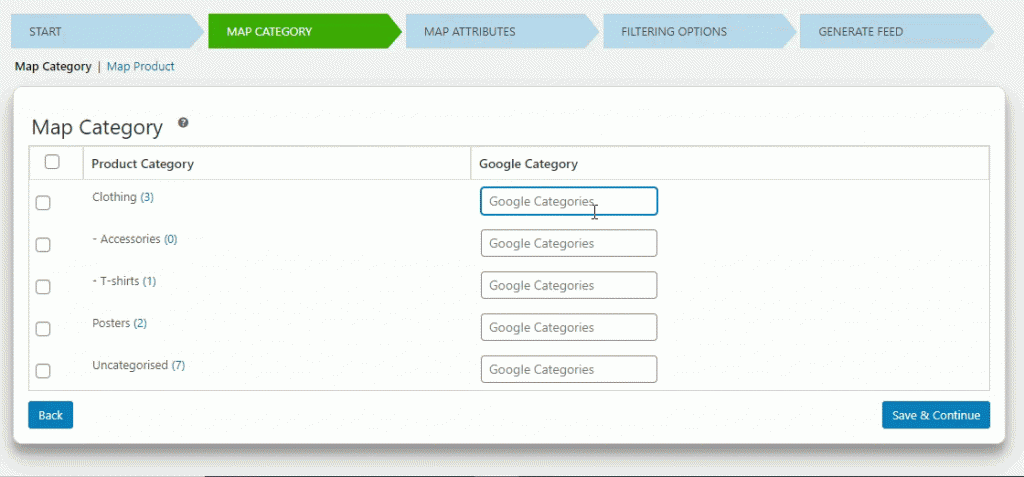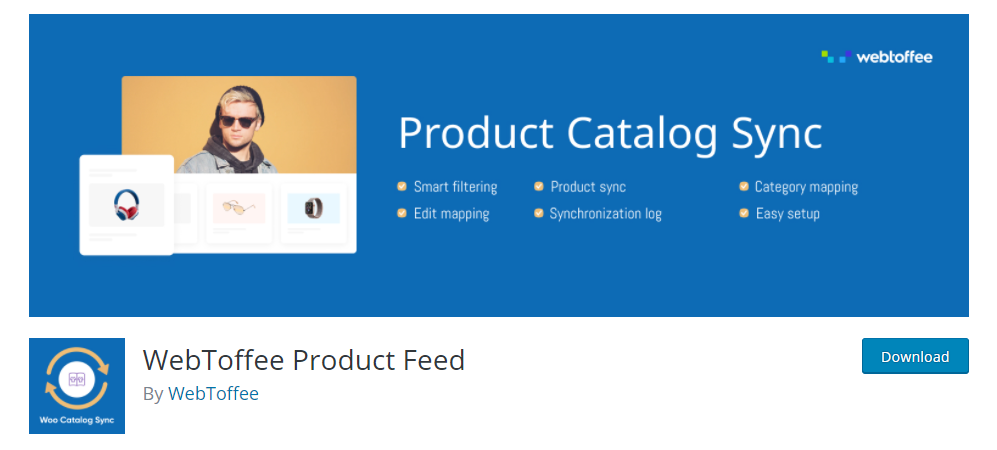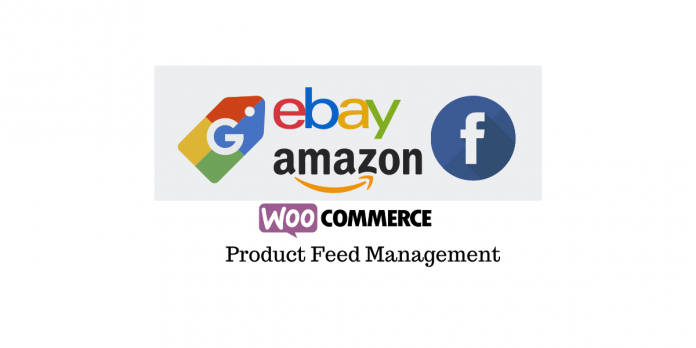Last updated - June 9, 2021
Selling through multiple channels is somewhat a necessity for modern eCommerce stores. It improves the visibility and reach for your products. And naturally, you will find more conversions as well as a result of this. Though it is a great way to increase your customer base, the process of retailing on multiple channels is practically challenging. One of the efficient ways to manage multiple channels is integrating all the channels and managing it in a centralized manner. So you will be able to sync the products on your WooCommerce store with Amazon, eBay, Google Merchant Center, etc. In this article, we will try to exhaustively cover WooCommerce Product Feed Management and the related aspects.
Why do you need a Product Feed?
A product feed will help you integrate your products to different retail channels and advertising avenues. In fact, it is simply a file with your products in a compatible format so that market places and search engines will be able to list them according to their specifications. Without a product feed, you will have to take a lot of manual efforts to get your products listed on another channel. A product feed will save you from all the associated hassles and offers you a chance to instantly sync your products. Moreover, you will be able to update the products instantly without delays.
How a product feed will help?
A product feed can be of help in some of the obvious scenarios where:
- You want to list your products on popular marketplaces like Amazon and eBay.
- Feature your products on product searching and comparison services like Google Shopping.
- Maintain information across channels consistently.
- Increase the visibility of your products and reach more users easily.
- Improve sales and conversions as you are targeting users more effectively.
What features are relevant in a product feed?
Now, when you are considering to create a product feed, you need to look for certain features. Features that should make it compatible to the avenues you are targeting. In addition, the feed should be flexible for you to handle it without hassles.
Here are a few essential features of a good product feed:
Accurate and extensive product information
You should be able to incorporate accurate and extensive information as product data in your feed. Users accessing that data through multiple channels should be able to understand your products thoroughly. Most of the marketplaces and product searching services have their own guidelines for product data. In fact, this will help you feature more relevant and specific information in the product feed.
Prompt updates
The product feed should be capable of prompt updates. It is quite possible that you have several updates for your products. For example, stock quantity will be changing naturally when customers are purchasing your products. Or, you might add some additional text in the description of a few of your products. Your product feed should be able to be updated automatically according to the changes you make in different fields.
Basically, when you make changes on your WooCommerce site, it should reflect in other places where your products are featured. More importantly, this should happen without much delays. If your product information is inconsistent across channels, customers might quickly lose trust in your products.
Flexibility to enhance the feed
Your product feed should be able to fulfill all the specifications of the respective channel you are trying to feature your products. Moreover, it should be flexible to include additional information to your products. The more attributes you are able to include per products will improve the chances of the product to get noticed.
WooCommerce Product Feed Management for Amazon and eBay
When your try to feature your products in other marketplaces and retail channels, you have to consider how you will be able to manage them. Each marketplace will have its own specific process in listing products. Moreover, in certain cases, you might have to spend quite a lot of time in listing on marketplaces. This may not be really good for your sales strategy. So, it is better to identify a few options that could bring in the best results for your store and more efficient WooCommerce product feed management.
Why do you need to list your products on Amazon?
Listing your products on popular marketplaces is a matter that requires special consideration from store owners. For some it might bring great benefits, while for others maybe not so much. So the specific nature of your store and products will come into the picture when you think about featuring your products on popular marketplaces like Amazon and eBay. However, we will first look into some of the general advantages that you might get when you list your products on Amazon.


Increased visibility
Amazon is a channel that has huge traffic. So, when you are listing your products on Amazon, naturally the visibility of your products is going to increase considerably. All this visibility holds the potential to convert into sales as well. According to general perception, listing products on Amazon can help to increase your sales by an average of 50%.
Acquire new customers
Acquiring new customers is one of the foundations of a successful eCommerce business. Amazon helps with this process quite effectively. That is because, as a marketplace Amazon is quite popular and a lot of people use it for product research. The possibility of users finding your products will organically increase if you have listed them on Amazon. This may not happen quite the same way, if you have your products listed only on your WooCommerce store.
More chances of conversion
Customers have varied interests. There will be a lot of customers who prefer to shop from only specific channels due to the familiarity or trust factor. For a hugely popular marketplace, this might be even more pronounced. So, by listing your products on Amazon, you are naturally increasing the chances of conversion among such customers.
Leverage exceptional customer service
Now, your success as an eCommerce store is dependent on your customer support as well. When you are selling through Amazon, you are in fact leveraging on their superior customer service as well. Actually, this can increase the chances of repeat purchases of your products. Customers who regularly purchase from Amazon will be more open to purchase other products from you if their initial experience is good.
More importantly, you can make use of Amazon’s infrastructure for inventory management and fulfillment. When you opt for Fulfillment by Amazon (FBA), you are actually making use of better fulfillment options as well as reducing a lot of hassles. In addition, Amazon has a huge affiliate network, of which some may advertise your products on their site. This would be an added advantage to your marketing efforts.
How syncing with eBay will help your store?
Just like Amazon, eBay too is a huge traffic channel, and has a global reach. Let’s examine a few aspects you might want to consider in favor of listing products on eBay.


Global reach
eBay has a great global presence. So, it provides you a great chance to reach out to several international markets that might be tough for you otherwise. Furthermore, the shipping woes are lesser when you try and sell to international customers.
Better SEO
If you are competing for search engine rankings with products listed on eBay, it can be quite challenging. However, when you are listing your products on eBay, you will be taking advantage of their SEO instead of competing with them.
Auction listing
eBay has an option for auction listing, which might be quite useful when you have products of high demand and low stock. Basically, you will be able to receive bids to your products, and gives you a chance to sell it to the highest bidder. Please note, eBay charges an insertion fee to list your item as an auction listing.
Bank into loyal customer base
Just like Amazon, eBay too has a loyal customer base who prefers to shop from them. It will be easier for you to benefit from this pool of customers when you list your products on eBay.
More cost effective
Though eBay charges a fee to list your products on their site, it is still lower than a lot of other places. Please note, after a sale they charges a commission as well. The rates are pretty low compared to similar marketplaces. Comparing the benefits that it offers listing products on eBay is a cost effective option.
Why sync products in multiple retail channels?
When you are selling on multiple channels, you need to sync product data between the channels so that stock information is updated real time. For example, if a sale happens on eBay or Amazon, the stock quantity should reflect these sales on your WooCommerce store as well. More importantly, when you retail through multiple channels, it is better if you keep your WooCommerce store as your primary retail channel and the marketplaces as secondary ones. Good WooCommerce product feed management should mean that your products are synced without confusion for those who are managing the inventory.
How to sync WooCommerce products with Amazon and eBay?
Now, let’s see some options that will help you sync your WooCommerce products. These tools guarantee a better WooCommerce product feed management that is fast and powerful.
Amazon and eBay integration for WooCommerce
This is a great solution to integrate your WooCommerce products to Amazon and eBay. The plugin offers an integration with Codisto, which is actually providing the marketplace listing and inventory sync. Though the extension is free, to integrate with Codisto you need to subscribe to one of their paid plans. With the help of this extension, you can list products from your WooCommerce store to Amazon and eBay in quick time. Moreover, it offers a complete WooCommerce product feed management for Amazon and eBay.


You can create new listings on Amazon or eBay, as well as link existing listings on these marketplaces to products on your WooCommerce store. If required, you can create different prices and fulfillment criteria for products on Amazon and eBay. Basically, the extension allows you to receive orders from Amazon and eBay on your WooCommerce store admin.
It is a great tool for WooCommerce product feed management as it helps you sync inventory, orders and product details in real time. As soon as a sale is made on any of your channels, it will reflect on all channels such as your WooCommerce store, Amazon and eBay. Moreover, the spreadsheet like interface will help you with WooCommerce product feed management. You can easily filter fields and make quick changes to listings, and even toggle the sync settings. The pricing plan starts at $29 per month.
Veeqo
Veeqo offers a great solution for multichannel inventory management. While taking care of your inventory, orders and shipping, it helps you ensure a great experience for your customers as well. It helps you with a centralized WooCommerce product feed management option by helping you sync your inventory across Amazon and eBay. This makes sure that you have a precise view of your inventory and sales trends across all retail platforms. And, that ensures that you are always on top of customer experience, which will result in repeat purchases.


Furthermore, it makes order management particularly easy on your store. You will be able to handle orders from your physical store, Amazon or eBay and your WooCommerce store in one location. Moreover, you will great assistance in your fulfillment process too. Veeqo has around 14 shipping carriers integrated into the solution to help with your order fulfillment. These include popular shipping carriers such as FedEx, UPS, USPS, DHL, etc. The pricing plan starts from $200 per month for three users for the plan suitable for upto $700k turnover.
WP-Lister Pro for eBay
This plugin is a great option to list and manage your WooCommerce store products on eBay. It will help you list unlimited products on eBay and map the categories on your store with that of eBay’s. With the help of the pro version of the plugin, you can sync inventory and sales between your WooCommerce store and eBay listings. You can benefit from the domestic and international shipping options, while the plugin supports shipping option calculations.


WP-Lister Pro for eBay allows you to create custom templates for your eBay listings on WordPress post editor. The template editor is quite user friendly with syntax highlighting for CSS and HTML. You can access the orders from eBay on your WooCommerce admin panel. If you need the plugin only to list your products on eBay and not for sales sync, you can download the free version from the WordPress plugin repository. The Pro version single site license would cost you $129.
WP-Lister Pro for Amazon
This plugin helps you to integrate your product catalog with Amazon. It will reduce a lot of manual efforts needed otherwise to list all your products on Amazon. Moreover, the plugin helps you sync sales between both WooCommerce and Amazon so that any changes in stock will reflect in both. You can create new listings on Amazon with products selected from your WooCommerce catalog, or you can match to existing products on Amazon. In addition, the plugin allows you to import products from Amazon to your WooCommerce store as well.


You can create orders on your WooCommerce store for the orders you receive on Amazon. More importantly, the plugin offers a repricing tool that will be quite useful to modify the price of your products comparing it to the lowest price on Amazon. The premium version of the plugin is priced at $149 for a single site license. If you don’t require the advanced features of the plugin, you can download and use the free version from the WordPress plugin repository.
Google Shopping Ads – What are the benefits?
Featuring your products on Google Shopping ad campaigns is a very effective way to promote. With the help of these ad campaigns, you can target customers right from their initial searches on the product itself. When a customer types a keyword related to your products, shopping ads including your products will be displayed to them on Search Engine Results Pages (SERP). This offers great advantage for a WooCommerce store owners, as it will help attract a lot more potential customers to your stores.
How to get your products listed on Google Shopping Ads
To get your products listed on Google Shopping Ad campaigns, you need to set up a Google Merchant Center account and add your product data to it. For getting your products featured on Google Shopping campaigns, you need to also set up an account with Google Ads. Later, you can link both accounts to create targeted shopping ad campaigns for your products. Then will Google will show the ads for relevant searches, and helps to bring in more customers to your WooCommerce.
Though it is different from the multi channel retail strategy that you employ for eBay or Amazon integration, the WooCommerce product feed management is similar. You have to generate a feed of your products to be submitted to Google Merchant Center. Google Merchant Center has strict guidelines on the nature of the product feed. Also, you have to keep update your feed within a minimum time interval of 30 days. Though you can manually upload a sheet to Google Merchant Center using Google Sheets, it is better to have a tool for automatic feed management.
WooCommerce extensions for Google Shopping integration
You can find a bunch of useful plugins in the WooCommerce ecosystem that will help you with automatic WooCommerce Product Feed Management. These plugins help to upload the product data on your Google Merchant Center account and help you upload them periodically. Let’s take a quick look at some of the popular ones.
ELEX WooCommerce Google Shopping Plugin (Google Product Feed)
This is another great option to create and manage an automated product feed for Google Shopping Ad Campaigns. The plugin helps you create an XML/CSV/TSV file with your WooCommerce products, which can be easily uploaded to Google Merchant Center. You can also provide a url of the file to Google, which will be periodically updated. Furthermore, you can set up a cron job with this plugin to update the product data within a specific time period. You can schedule a daily, weekly or monthly cron job, depending on the frequency of updates on your WooCommerce store.


You can include variable products and specific variations so that users can easily find those in their Google searches. It also helps you match multiple Google categories to your WooCommerce store categories so that your products stay relevant to diverse search terms. The simple interface of the plugin allows you to easily map required Google fields with WooCommerce fields. Moreover, it offers great settings for WooCommerce product feed management when you have multiple product feeds. The plugin costs $69 for a single site license.
WooCommerce Google Product Feed
This WooCommerce extension helps you with an option to provide a product feed to Google Merchant Center and periodically update it. The extension helps you provide product information complying to all the guidelines mandated by Google. In fact, adhering to Merchant Center guidelines ensures that your products get the best visibility, and this extension helps you with that.


You can additional product fields, which Google requires, even when they are not normally part of your WooCommerce product fields. The extension allows you to configure information globally across products or specific to particular categories. Apart from Google Product Feed and Product Review Feed, the plugin also helps you create a feed for Bing.
YITH Google Product Feed for WooCommerce
This plugin helps you create product feed for Google Merchant Center. You can choose to include all the products on your WooCommerce store, or choose them based on categories or tags. Apart from the mandatory fields, you can choose which all Google fields you want to include in the field. If certain Google fields don’t have corresponding ones on your WooCommerce store, you can create these as custom fields separately.


A special feature of the plugin that will help you create feeds faster is the option to add general values to Google fields. In addition, for required products, you can override the general settings. Please note, you can generate Google product feed files in .xml and .txt formats using this plugin. The single site subscription of this plugin has a price of €79,99.
Advantages of listing your products on Google Shopping
Traditional online ads are a great way to improve sales and conversions on your WooCommerce store. It might be even better to make targeted Google Shopping ad campaigns, which is getting quite popular by the day. Let’s take a deeper look at some of the reasons that will make Google Shopping ad campaigns so effective and popular.
It drives useful traffic
One of the primary benefits of advertising is that your products will have a better reach to a vast section of audience. Even traditional ads help to spread the word about your product, and the result will be a steady influx of traffic to your site and product pages. There is a marked difference here when it comes to Google Shopping ads. Due to the comprehensive nature of Google ad listings, users already have a decent idea regarding your products and features. In fact, they already know about your product’s features and price, and also have read reviews and seen images before landing on your site. This means that the traffic directed to your site is much more likely to convert.
Since the initial product research is already in progress with each Google Shopping listing, you are in a better position to acquire new customers. The purchase intent is naturally high among the users who land on your site through Google Shopping ad campaigns.
Get a wider reach
The nature of Google product feed allows you to include maximum attributes of a product. This naturally would increase the reach of your products to a wider range of audience. For example, each variation in a variable product is qualified to appear on Google searches based on their relevance to the search terms. This means by better WooCommerce product feed management, you can increase the visibility of each of your products.
Capture the attention of prospective buyers
Since each listing on Google Shopping ad campaigns is laden with information, you have better scope to catch the attention of potential buyers. If your product information is more organized and effective, that will naturally be capturing the attention of your prospective buyers. By using a good WooCommerce product management tool, you can enrich product data by incorporating more attributes to each product.
Cost effectiveness
Since Google Shopping ads offer more extensive data of each product, the click through rate (CTR) is generally high. It helps to reduce your cost per click, and as a result offers better return on investment for your marketing efforts. On an average, Google Shopping ads offer 26% better conversions compared to traditional text ads.
Easier to manage
If you are using an automated solution for WooCommerce product feed management, the whole process will be quite easy for you. For example, if you are using one of the WooCommerce extensions mentioned above, adding and updating a product feed is an effortless process. All you have to do is to set up your product feed by including all the necessary attributes of a product. And, then upload your feed on Google Merchant Center and specify an update interval.
The feed will get updated at specific intervals reflecting any changes you make on your WooCommerce store. The whole process of displaying relevant results according to search relevance will be taken care by Google. Please note you will have to link your Google Merchant Center and Google Ads accounts for this to work.
Can make use of Automated bidding
With the help of automated bidding strategies you will be able to target specific marketing goals for your store. Google Ads, with the help of machine learning, will help you automate the process of optimizing bids across keywords. For example, you can set specific goals for your store depending on the requirements such as increase site visits or product visibility. Or you can optimize your campaigns to ensure maximum conversions. Find more details on automated bidding here.
WooCommerce Product Feed for Facebook Catalog
You will be able to generate product feeds to create a Facebook catalog that will have information about your products that can be used for ads as well as for shopping through Facebook. From your WooCommerce store, you can import product information to the Facebook catalog after integrating your store with Facebook.
We will take a look at some of the plugins that will help you create product feeds for Facebook.
Facebook for WooCommerce
With this plugin, you will get a range of options to market your products through Facebook. It will let you create a Facebook Shop by integrating and synchronizing your WooCommerce products with a Facebook Catalog. You will be able to manage the catalog smoothly, as well as easily create ads and product tags as per requirements. For US merchants, this also offers the Checkout on Instagram option, which allows customers to purchase products directly from the Instagram app.


Moreover, you will be able to derive actionable insights from Facebook Pixel, and also offer customer support through Messenger.
Product Catalog Feed for WooCommerce
This plugin helps you create multiple product feeds suitable for different marketing and retail channels such as Facebook, Google Shopping, Pinterest Catalog, etc. It will create automatically updated feeds in XML format, which you can download in XML and CSV formats. The plugin will also update the feed periodically so that the product information is up-to-date in marketing channels as well. Furthermore, you can easily manage multiple feeds.


Product Feed Manager For WooCommerce
With this plugin, you will be able to create product feeds suitable for different marketing channels such as Google Shopping, Facebook, eBay, etc. You can create a product feed for Facebook Dynamic Ads following all the essential guidelines. This can be manually uploaded to your Facebook Business account for dynamic ads. Also, the plugin has an intuitive interface that will let you easily create and manage feeds for different channels.


CTX Feed – WooCommerce Product Feed Generator
This plugin helps you create product feeds suitable for different marketing channels including Facebook Dynamic Ads. It will make sure that your feed is automatically updated in a timely manner. Moreover, the plugin offers pre-built templates for Facebook and instagram catalogs that allow you to ensure all the required fields are included. Additionally, the plugin offers advanced options for category mapping.


WebToffee Product Feed
You can integrate your WooCommerce store products with Facebook and have an additional sales channel, thanks to this plugin. It will help you to sync your products with your Facebook catalog pretty effortlessly. In addition, there are smart filtering options that will allow you to exclude specific products or categories from the feed. It also offers options for quick category mapping and bulk processing of products.


Explore the full benefits of multi-channel retail
Multichannel retail will help you offer more shopping avenues to your customers. In today’s digital landscape customers are trotting from one channel to another quite rapidly. Establishing your presence in multiple channels will ensure better reach and visibility for your products. Naturally, this will increase the overall sales and conversions of your products as well.
However, when selling through multiple channels, it is quite important to ensure that you are able to manage inventory and sales in a synchronized fashion. For best results in customer experience, you need to provide consistent product information on aspects such as price. You can manage multiple sales channels more effectively if you are using an automated solution for WooCommerce product feed management. Hope this article has provided some valuable information and useful tools for WooCommerce product feed management. Leave a comment to share your insights.











